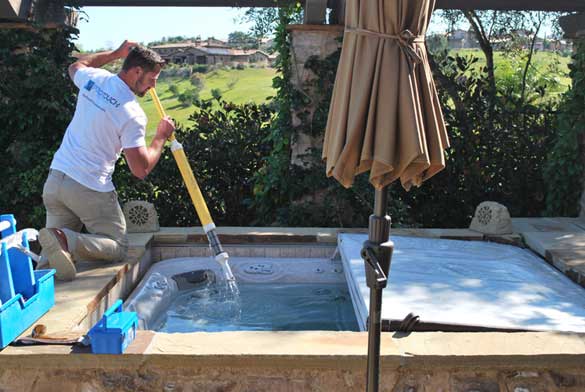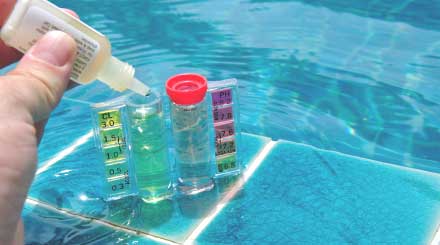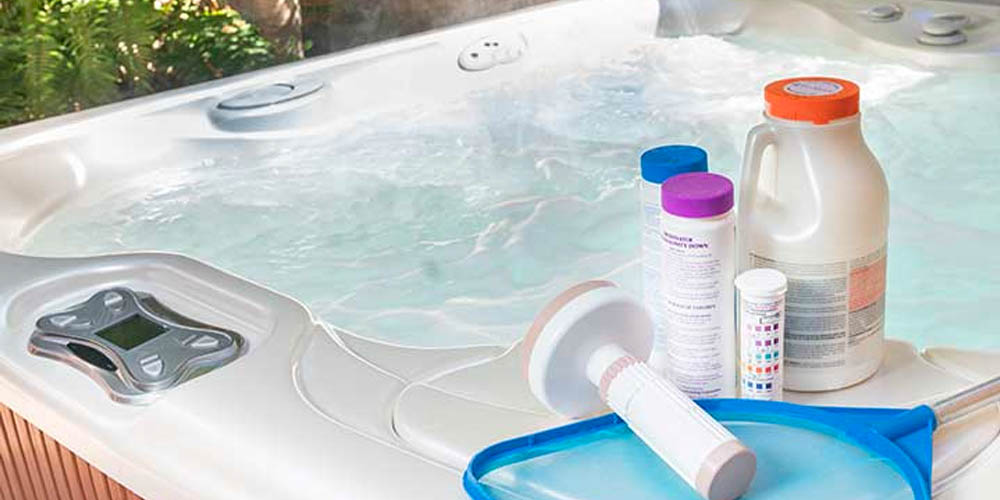A hot tub can be the ultimate way to relax after a long day or the best way to cap off a vacation weekend. Maybe that’s why just under 6 million homes in the U.S. have a hot tub. But there’s nothing more frustrating than getting ready to relax in your hot tub and uncovering it to find green water. Or even worse, finding a hot tub that doesn’t work at all.
No matter which hot tub you choose, it’s going to require routine maintenance. It doesn’t take as much work as a pool, but caring for one does require many of the same principles as a pool.
Fortunately, a little routine maintenance can go a long way. You can’t prevent all problems, but if you stay on top of regular maintenance, not only will you be able to use your hot tub any time you want, but you’ll keep expensive repairs at bay. And when problems eventually arise, you’ll be able to fix them more quickly.
The Best Maintenance Routine For A Hot Tub
When it comes to hot tub maintenance, it’s important to remember what experts refer to as the “three C’s” – that is cleaning, chemistry, and circulation.
Cleaning your hot tub
A simple weekly wipedown is one of the best ways to keep your hot tub looking great. Remember this won’t really help clean the water, but that’s the filter’s job. Your goal here is to clean the actual hot tub.

Using a sponge soaked in white vinegar, wipe down the lining including the walls, seats, floor and jets. It’s okay to do this while there’s water in the hot tub, just make sure you’re cleaning what’s out of the water and what’s in the water. In fact, it’s only recommended to completely drain your hot tub three or four times a year (completely changing the water at the start of every season is an easy way to remember this).
Once you’ve finished with that, wipe down the inside of the cover with a 90 percent water to 10 percent bleach solution. This is a great way to help keep mold and mildew away.
Want a little help keeping your hot tub clean? Toss a tennis ball in after you’ve used it. Hot water brings things like oil, lotion, and soap off of your skin, and hot tub filters aren’t great at removing those things. A tennis ball is perfect for soaking up those contaminants, keeping your hot tub water a little more clear.
Don’t forget to clean your filter. Spray it with a mixture of bleach and hot water (5 gallons of hot water to 1/4 cup of bleach), laundry detergent mixture (1 cup of detergent, 4 Tbs. of trisodium phosphate (Buy on Amazon), 5 gallons of hot water), or use a special hot tub filter cleaner once a week and rinse it out with warm water after. Every time you totally replace the water in the hot tub, soak the filter in cleaner and rinse afterward. Standard hot tub filters have a life of about one to two years depending on how often they’re used.
Chemistry in your hot tub

Having properly balanced chemistry is the most important ingredient in sparkling clean water. Just like a swimming pool, there are three areas of concern: pH, alkalinity, and sanitizer. You’ll need a water testing kit to analyze your water at least once every two weeks. Some of these kits use simple strips you insert in a water sample, while some are more high tech and offer a digital readout of your water levels. Either way, here’s what you’re looking for:
-
A pH level between 7.4 and 7.6. That’s the ideal range, but a level between 7.2 and 7.8 is still okay. If you go below that level, your water has too much base, and the sanitizer can’t work, leading to cloudy water. Go above that level, and water will be too acidic, eating away at the liner and equipment and probably irritating skin and eyes.
-
An alkalinity level between 90 and 140. Alkalinity gives water the ability to neutralize acid. Have a higher alkalinity, and you’ll have cloudy, scaly water. Let the alkalinity get too low, and the lack of minerals will make the water acidic, potentially damaging the hot tub.
-
A sanitizer level of 3 to 5 parts per million (ppm). If you’re using chlorine, the most common sanitizer, you’ll want to have an average of 3 to 5 million ppm to keep your hot tub clean.
Circulation in your hot tub
There’s a reason that wild animals generally prefer to drink from flowing water rather than still water. As a rule, water that’s circulating tends to be cleaner. And that’s true for your hot tub as well.
When your hot tub is circulating water, it’s passing water through the filter, cleaning it. That doesn’t mean you want it to run 24/7 though, as just cycling the water through a few times a day is sufficient.
Most hot tubs have an automatic timer you can engage. Take advantage of that! The generally accepted time for how long a hot tub should run is three to four hours at a time, twice a day. Many first-time hot tub owners are afraid to run their system too often, but that’s exactly what it’s set up to do, and it’s what the filters are there for.
Hot Tub Maintenance Schedule at a Glance
- Every week: Clean the skimmer basket, wipe down the inner lid and lining
- Every month: Clean the filter with a special cleanser and rinse it out
- Every season: Totally empty the hot tub, wipe it down, and refill, soak the filter in cleanser and rinse.
Bottom Line on Hot Tub Maintenance
If you’re considering a hot tub, you should be aware that regular maintenance is required to keep it in good condition. But don’t feel overwhelmed and don’t be scared away from ownership. Hot tubs today are more consumer-friendly than ever before and require much less care than hot tubs of years gone by. On a weekly basis, less than 15 minutes is all you need to run through the basic checklist.


